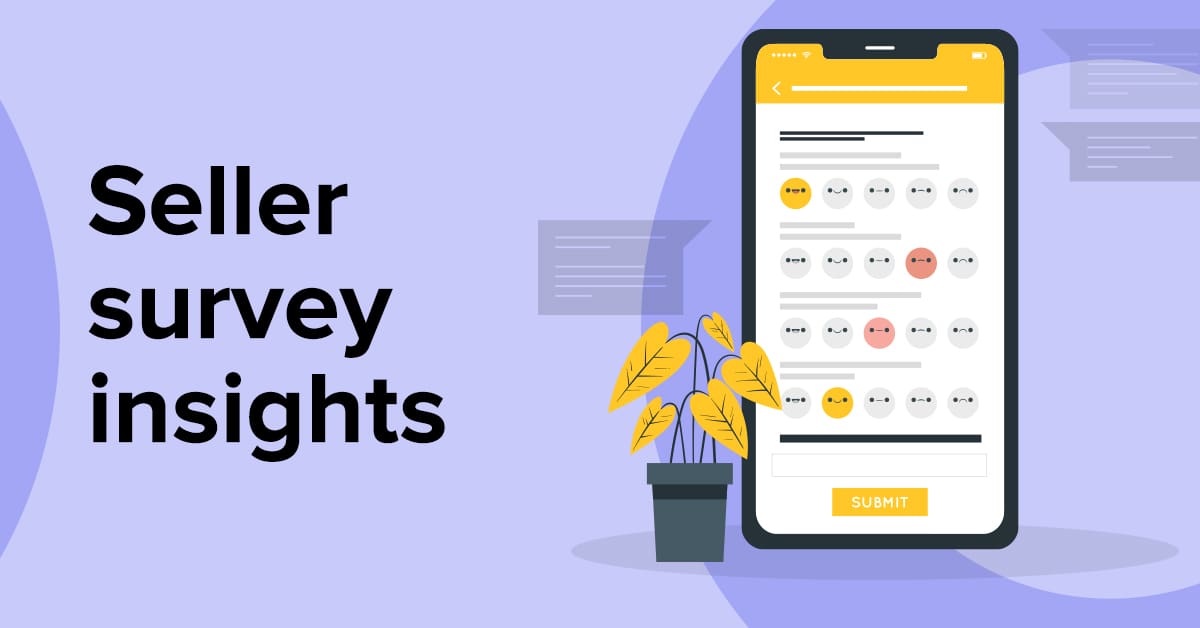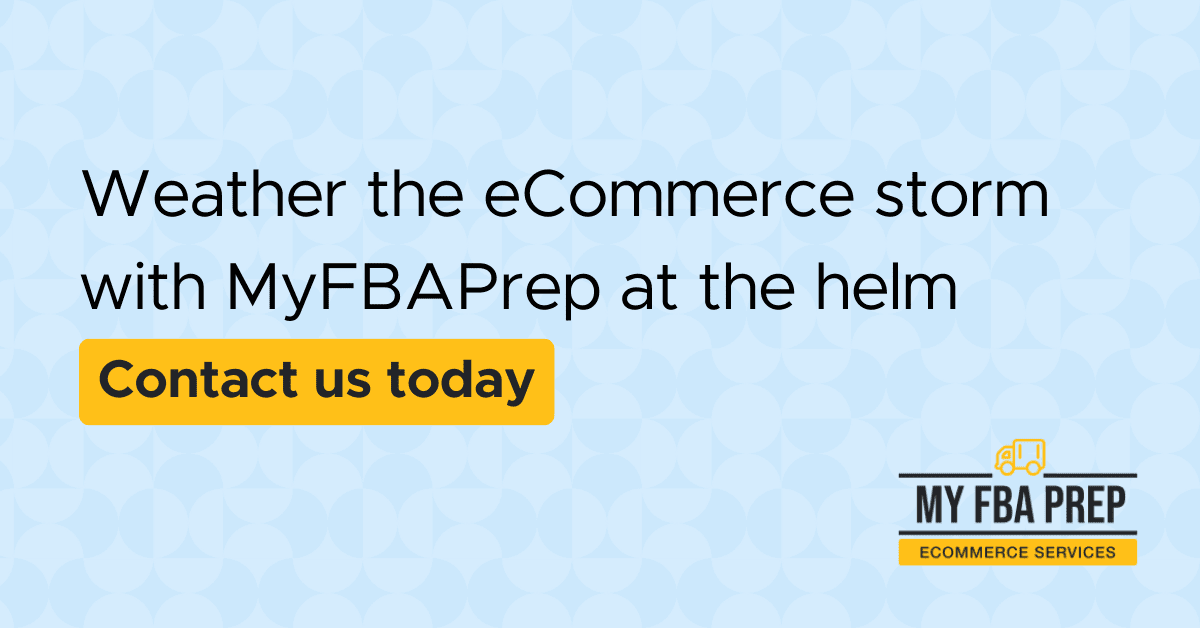
Seller Survey Insights 2023: Navigating Industry Changes and Meeting Evolving Consumer Demands

Over the last three years, millions of online businesses have displayed resilience in the face of the unexpected.
The COVID-19 pandemic accelerated the adoption and innovation of digital commerce, with online shopping increasing by 77% year over year in a matter of months.
By the end of 2023, eCommerce sales will make up one-fifth of all retail sales globally.
However, after years of lockdowns and restrictions, people crave meaningful connections across all aspects of their lives, including commerce. Physical spaces foster online and offline relationships between merchants and customers.
Now, brands must be flexible and responsive to challenges, adding flexibility to their products, strategies, and policies. To help you stay ahead of the curve, MyFBAPrep conducted a seller survey that sought to include eCommerce business owners across all channels and industries.
Our findings shed light on eCommerce merchants’ current priorities and challenges and highlight their priorities as they drive their businesses forward in 2023.
Join us as we explore the new eCommerce landscape and discover where it’s headed this year.
Where are retailers selling?
eCommerce merchants are selling their products and services in a variety of online marketplaces, including established marketplaces such as Amazon (47%), eBay (50%), Walmart (27%), and Etsy (33%).
Other merchants sell through their custom websites (14%) or on platforms such as Shopify (37%) and BigCommerce (12%).
According to our respondents, the top three sales channels are eBay, Amazon Marketplace, and Shopify. This clearly indicates that marketplaces are still thriving, but direct-to-consumer (DTC) sales are also gaining significant popularity.
Statistics reveal 43% of Amazon sellers generate between 25% and 50% of their revenue through Amazon sales, while 35% of DTC sellers generate a similar percentage. These numbers suggest that most merchants have transitioned to a multi-channel approach, leveraging a combination of marketplaces and DTC sales to drive revenue.
Where do retailers want to sell next?
As eCommerce continues to evolve, merchants are constantly searching for new sales channels to expand their reach and grow their businesses.
According to our survey, many sellers (39%) have their sights set on Amazon Marketplace as their next step forward.
For those already selling on Amazon though, the picture takes on a darker hue: Almost 30% are concerned about Amazon’s white labeling and potential competition with their products. It’s a valid worry that closely aligns with the second-most popular concern, which is a decrease in listing visibility or unfavorable algorithm treatment.
While Amazon is a powerful sales channel, these worries highlight the importance of diversifying sales channels, rather than relying solely on one platform.
Embracing a multi-channel approach
Amazon isn’t the only platform capturing the attention of growth-focused merchants; 31% of merchants also want to expand to Shopify. This shows an interesting exchange wherein retail and DTC sellers are interested in exploring Amazon, while retail and Amazon sellers are keen to pursue DTC sales.
These trends display how eCommerce is increasingly moving towards a multi-channel approach, with retailers utilizing a mix of sales channels to reach their customers. As a result, merchants can mitigate risk and take advantage of each channel’s unique strengths to further their business.
What is their average order value?
The data shows most merchants have an average order value (AOV) of $10–$50, with the second-most common AOV falling between $50 and $100.
If your cart sizes are smaller than this, consider employing AOV-boosting tactics to increase the value of each sale. These could include upselling and cross-selling, offering volume discounts, or creating product bundles. By focusing on boosting AOV, merchants can maximize revenue and improve profitability.
Which seller tools are merchants using?
Today’s eCommerce merchants use a multitude of seller tools to streamline their operations, improve efficiency, and enhance the customer experience. Some of the most popular tools include:
- AMZScout (15%): AMZScout is a suite of tools designed for Amazon sellers to research and analyze data related to item sales, competition, and profitability. It provides a range of features and functionalities to help Amazon sellers make informed decisions about their products and business.
- CedCommerce (15.6%): This multi-channel solutions provider offers various tools and services to help merchants sell their products online. CredCommerce boasts integration solutions for eCommerce platforms such as Magento, Shopify, WooCommerce, and BigCommerce, as well as marketplaces like Amazon, eBay, and Walmart.
- Channel Advisor (15.6%): A cloud-based platform, ChannelAdvisor can integrate with popular eCommerce marketplaces including Amazon, eBay, Walmart, and Alibaba, as well as social media channels like Facebook, Instagram, and Google.
- Ecomdash (11.2%): Ecomdash is a cloud-based inventory management software designed for small to medium-sized businesses. It helps merchants streamline inventory management, order fulfillment, and shipping processes across multiple sales channels.
- GeekSeller (16.2%): This comprehensive eCommerce management platform provides a range of customization options that enable merchants to tailor it to their specific needs. They can customize their workflows and automate repetitive tasks, freeing up time to focus on other aspects of their business.
- GoDataFeed (9.8%): Another cloud-based platform, GoDataFeed enables merchants to manage and optimize their product feeds for multiple sales channels. It automates the creation and updating of product feeds for marketplaces like Amazon, eBay, and Walmart, as well as shopping carts like Shopify and Magento.
- Custom-built software (28.8%): One of the most noteworthy statistics to come out of our survey is the number of merchants using custom-built software. Custom software can give merchants a competitive advantage by providing unique and innovative features and functionalities unavailable in off-the-shelf solutions.
Which newsletters and podcasts do merchants subscribe to?
Staying current with the latest trends is essential in the evolving eCommerce industry. With so many resources available, like top marketing blogs and intriguing podcasts, there’s no shortage of in-depth topics and trends to explore.
Below are our results on the most popular podcasts and newsletters merchants are following:
- Shopify Retail Radar: With nearly 1.7 million merchants selling their products through Shopify, it’s no wonder the platform’s newsletter is full of valuable resources and inspiring success stories. Subscribe to the free Shopify Retail Radar newsletter and receive monthly news about eCommerce updates, thought-leader interviews, and advice from industry experts. Whether you already run an online store on Shopify or are considering launching one, this newsletter is a must-read for anyone looking to stay ahead of the game.
- Digital Commerce 360: Digital Commerce 360 is a leading research and media organization that provides objective B2B news, eCommerce analyses, and in-depth market research. When you sign up for their newsletter, you can choose to receive either retail or B2B news (or both) according to your interests. Both options will give you daily news and insights (Monday to Wednesday) about eCommerce trends and strategies from top experts in the field.
- Ecommerce Playbook: Hosted by Andrew Faris, former CEO of an eCommerce aggregator and current VP of growth for an eCommerce growth agency, the Ecommerce Playbook podcast is packed with valuable insights and firsthand experiences. Andrew shares his personal journey, including both recent successes and past failures, with listeners. He also invites fellow entrepreneurs to join the conversation and recount their own eCommerce stories.
MyFBAPrep curates the best news in shipping and operations every other week. Subscribe to our newsletter to stay on top of the market and join over 3,000 fulfillment experts who enjoy the industry’s most relevant news.
What are the top acquisition channels?
The top acquisition channels for eCommerce vary depending on the specific business and industry. Here are our respondents’ top acquisition channels:
- Social media (62.2%)
- Amazon ads (36.6%)
- Referrals/Affiliates (30.4%)
- Videos (25.4%)
- Email outreach (27.4%)
- Paid social ads (28.2%)
- Influencer marketing (21.8%)
- Paid search ads (21.2%)
- Brand partnerships (16.2%)
- Content marketing/SEO (14.8%)
Looking toward social commerce
With social media coming in at number one, today’s merchants are obviously focusing more on social commerce.
Social media platforms like Instagram, Facebook, and Pinterest have introduced features to support social commerce, including shoppable posts and tags, buy buttons, and in-app checkout. These features allow users to browse and purchase products directly from their social media feeds without having to navigate to a separate website.
Social commerce sales in the U.S. are projected to grow by 34.4% this year, reaching $53.1 billion. Retailers who are able to overcome the trust gap will reap the rewards, attracting a wave of new shoppers and inspiring existing customers to spend more.
Capitalizing on Amazon ads and referral marketing
Amazon ads and referrals take second and third place, respectively. This underscores the large number of merchants utilizing Amazon as a key sales and acquisition channel, as well as the effectiveness of referral marketing.
Amazon ads are a powerful avenue for showcasing your products to potential customers. You can ensure your ads reach the right audience by using a range of targeting options like keywords, interests, and demographics.
Referral marketing is another highly effective acquisition channel for eCommerce businesses. By incentivizing current customers to refer their friends and family to your brand, you can tap into a network of new leads who are already interested in what you offer.
Implementing a loyalty rewards program is a savvy strategy for boosting customer lifetime value (CLV). Learn how to launch a successful referral program.
How are online retailers fulfilling orders in 2023?
The following are the most popular fulfillment methods for today’s merchants:
- In-house (60%)
- Amazon FBA (33.2%)
- Amazon multi-channel (27.4%)
- Third-party logistics (3PL) provider (21.4%)
- Dropship (17%)
Identifying logistics concerns
After years of digital transformation, unprecedented growth in eCommerce, and supply chain challenges, the industry experienced a significant shift in 2022. Rising costs and concerns about a potential recession contributed to a slowing of its upward trajectory.
This year, merchants are focusing on anticipating the changes that’ll shape the sector and identifying new opportunities. Their most pressing concerns include:
- Shipping mistakes (42%)
- Expensive shipping (37.2%)
- Lack of services (23.2%)
- Inventory loss, theft, or breakage (27.2%)
- Poor communication (28.2%)
- Inaccurate receiving (20%)
- Unreliable manufacturers (18.8%)
- Unreported damages (17.8%)
- Long prep turnaround time (15.2%)
- Limited visibility or no inventory reports (14.8%)
- Geographic constraints/Limited warehouse locations (13.2%)
- Backlogs and no SLAs (12.6%)
- Unfamiliarity with FBA standards (11.2%)
- Containers sitting idle (10%)
- No reverse logistics processes (7.2%)
Overall, merchants need to pay close attention to logistical concerns to ensure their operations are efficient, cost-effective, and sustainable while also meeting their customers expectations.
Top 3PL providers
For those merchants using 3PLs, their most commonly used partners are:
- FedEx (58.9%)
- UPS (43.9%)
- Amazon Multi-Channel Fulfillment (35.5%)
- USPS (28.9%)
- eFulfillment Service (23.4%)
An overwhelming majority of our respondents found their 3PL through social media (39%), with friends or family (15%) coming in second.
When choosing a 3PL, these online retailers consider price (56%) and delivery speed (46%) to be the most influential factors, with reliability (45%), ease of use (40%), and customer service (33%) closely following.
What are merchants prioritizing in 2023?
In 2023, eCommerce merchants are prioritizing a range of strategies to remain competitive and meet evolving consumer demands.
Increasing customer retention (32%), growing teams (32%), and content marketing (29%) are top points of focus for retailers this year. These goals are in line with experts’ predictions for the coming year.
The emphasis on retaining existing customers is based on the statistical probability of selling to an existing customer versus a new prospect: While the likelihood of selling to an existing customer is 60%–70%, the chances lower to just 5%–20% for new prospects. This underscores the importance of building strong customer relationships and providing exceptional experiences that keep customers coming back.
Wondering how to optimize your post-purchase experience to boost customer retention? Our blog explains how to deliver a memorable experience for your customers.
Other priorities for merchants in 2023 include building brand awareness (26%), optimizing fulfillment (25%), and catalog expansion (21%).
Wrapping up — The only constant in eCommerce is change
Our Seller Insights survey highlights the significant shifts and challenges that the eCommerce industry has experienced in recent years. From changing consumer expectations to supply chain disruptions, merchants have had to adapt quickly to remain competitive.
Looking ahead, sellers are prioritizing strategies like customer retention, multi-channel selling, brand awareness, and data-driven decision-making to optimize their operations and meet evolving consumer demands.
By staying informed and agile in the face of these ongoing fluctuations, eCommerce merchants can weather the storm and continue to drive growth and success in their businesses for years to come.


